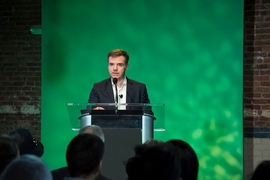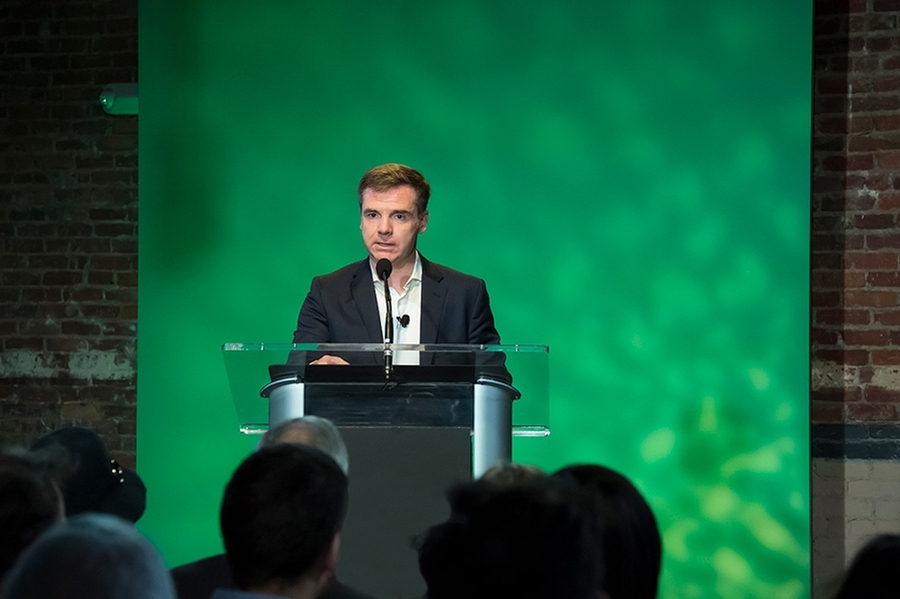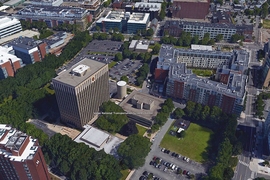Today, MIT and the U.S. federal government signed an agreement creating a path for MIT to redevelop 14 acres of federally-owned land in Kendall Square that is now home to the John A. Volpe National Transportation Systems Center. Under the agreement, MIT will build a new facility to house the Volpe Center on approximately four acres of the parcel; once that construction is complete, the Institute will purchase and redevelop the remaining 10 acres.
Israel Ruiz, MIT’s executive vice president and treasurer, spoke with MIT News about why the Volpe investment makes sense for the Institute, how it is in keeping with a long history of similar investments, and how it will benefit both MIT and the city.
Q. How will this transaction work, and how is MIT paying for this property?
A. The agreement signed today by MIT and the U.S. General Services Administration (GSA) outlines a multistep process by which the Volpe Center parcel will be partitioned, transferred to MIT, and developed.
First, MIT will construct a new building to house the Volpe Center, replacing the 375,000 square feet of office space now on the site. This new structure will occupy approximately four acres of the 14-acre parcel — and these four acres will remain the property of the federal government.
Our bid included the cost to build this new federal facility as well as payment for the land that MIT will acquire through the transaction. Once the new Volpe building is completed and transferred to the GSA — perhaps in four or five years — MIT will pay the balance of its bid price to the federal government. At that point, the government will transfer ownership of the remaining 10 acres to MIT.
The Institute is investing $750 million to purchase this sizable parcel adjacent to our campus — including the cost of constructing the Volpe building. It’s important to note that the money to purchase the Volpe property is coming from MIT’s investment funds, and not from the Institute’s operating budget or academic funds.
We are fortunate that MIT has the ability to take advantage of this historic opportunity. The Volpe site is the only remaining undeveloped parcel of land in the Kendall Square innovation ecosystem. It is difficult to imagine that MIT will ever again be in a position to purchase such a large parcel of land close to our campus — so this transaction has special value to MIT.
Q. How will MIT benefit from its investment in the Volpe property?
A. This new land will be key to our work in nurturing the growing innovation hub in Kendall Square — already one of the most exciting such districts in the world.
MIT is intensely interested in supporting the evolution of an innovative, mixed-use community in Kendall Square. The Institute has made concerted efforts to foster the advancement of Kendall Square, aiming to maintain the very special innovation ecosystem in Cambridge.
Our engagement with the Volpe property will allow us to further contribute to the vibrancy of the Kendall Square area — which will provide long-term benefits for our neighbors, for the city, and for the Institute itself. Our work with the Volpe parcel will contribute to an even more exciting Kendall Square for members of the broader community to live and work.
The size of our investment in the Volpe property matches the transformative potential of this parcel for MIT. The long-term proceeds from this investment will support the Institute’s academic and research enterprise for many decades to come.
With this purchase, MIT will significantly expand its real estate portfolio — which is an investment in and for the future. In recent years, we have done the same with other investment properties, such as 610 Main St. (now the site of a major Pfizer research facility) and Technology Square (now the home of the Novartis Institutes for Biomedical Research and several other companies). Indeed, investing in Cambridge real estate has been a critical component of MIT’s investment strategy for decades.
This investment is smart for MIT because continuing to invest in real estate, alongside stocks, bonds, and other investments, helps diversify our portfolio, providing stability of endowment returns in a variety of economic conditions.
Q. How will Cambridge benefit from MIT’s investment in the Volpe property?
A. MIT helps to advance the local innovation ecosystem in a variety of ways — by churning out research, ideas, talent, and companies. But the Institute also supports the Cambridge knowledge and innovation economy by investing in land and infrastructure in ways that serve to strengthen the broader community. MIT puts its real estate resources to work to increase the city’s housing stock (including affordable housing), create vital open space, attract unique retail and restaurants, and contribute to the enhancement of the overall quality of life within the city.
The Institute’s historical practice of investing in the City of Cambridge falls into two categories of property use. MIT owns 166 acres of academic property that is legally tax-exempt because it serves the Institute’s nonprofit mission of teaching and research. While no real estate taxes are required on academic property, MIT provides a “payment in lieu of taxes” (PILOT) to Cambridge of approximately $2 million annually, based on an agreement with the city. MIT and Harvard were the first universities in the country to offer their host municipalities voluntary PILOT contributions, beginning in 1928. This nearly 90-year-old tradition remains unique among “town-gown” relationships in the nation, and provides the city with a predictable and reliable source of revenue.
Not counting the Volpe parcel, MIT also owns 92 acres of investment property in Cambridge, which is taxable because it is used for commercial purposes. This kind of property might be leased to a global pharmaceutical company or a local startup company that has emerged from an MIT lab. The Institute pays real estate taxes on its investment land, and in so doing, has been the city’s largest taxpayer for many years. In 2016, MIT’s $45 million tax payment represented more than 14 percent of the city’s total tax revenue. That payment, along with the PILOT contribution, would cover the operating costs of the entire Cambridge Public Library system, Cambridge Rindge and Latin High School, Fletcher Maynard Academy, and Morse Elementary School.
But MIT’s investment in Cambridge real estate yields more than enhancements for the overall community, revenue for the city, and financial returns for MIT. By investing in land and buildings near campus, MIT is able to attract companies to participate in Cambridge’s strong innovation ecosystem. The “power of proximity” is a critical factor as we work collaboratively in Cambridge to accelerate the pace and progress of innovation. Researchers from companies leasing from MIT are in close proximity to Institute researchers who are working in similar fields. Their ability to simply cross the street in order to share ideas and brainstorm around serious challenges facing the world expedites the process of discovery and the advancement of solutions.
Finally, because of their economic stability and vibrancy, the City of Cambridge and MIT are assigned the highest bond ratings given by the nation’s three rating agencies — Moody’s, Standard & Poor’s, and Fitch. In great measure, this is in recognition of the strength and future promise of the city’s innovation ecosystem and MIT’s pivotal role in advancing it — certainly as a result of the Institute’s world-changing teaching and research activities, but also because of its longstanding local investment practices. These high ratings give MIT and the city the ability to further focus on city-wide priorities, and address needs that will help to strengthen the diverse and unique Cambridge community that we share.











